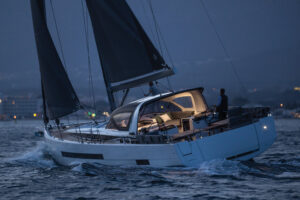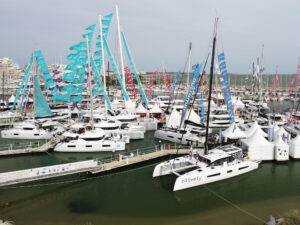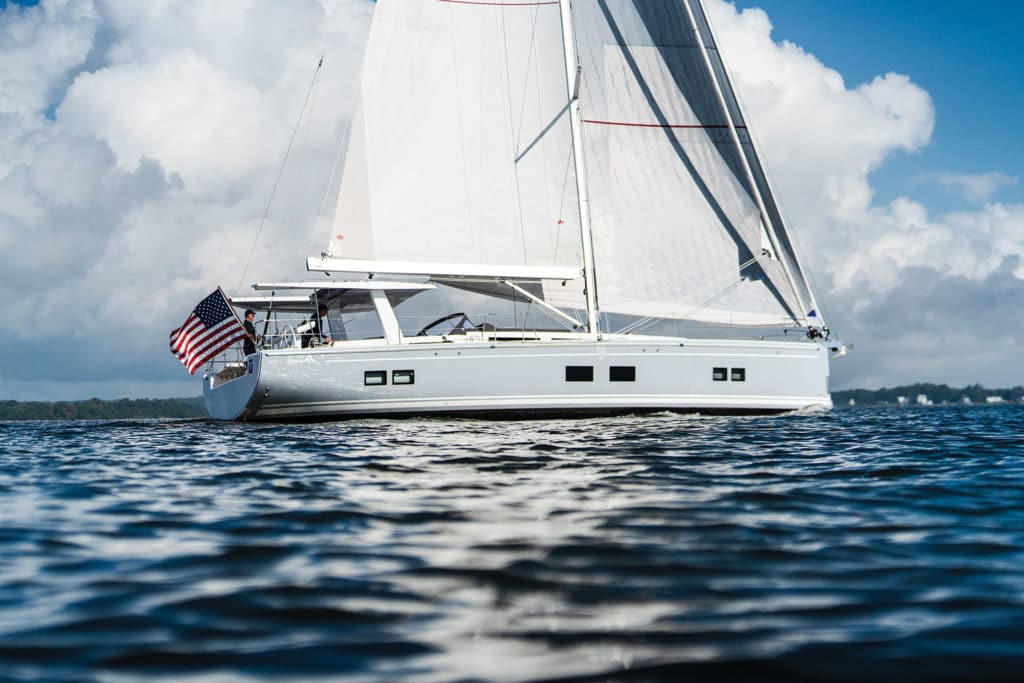
A funny thing has happened in the world of production boatbuilding since the German company Hanse Yachts launched its first model, the relatively modest Hanse 291, in 1993. To put it mildly, Hanse has exploded and is now a certifiable behemoth, trailing only Group Beneteau in the ranks of the world’s largest sailboat builders (the firm’s holdings include the Moody and Dehler brands, and Privilège Catamarans as well). Pay a visit to the Hanse stands this fall at the big U.S. boat shows in Newport, Rhode Island, and Annapolis, Maryland, and see for yourself. The Hanse exhibit is a veritable boat show within the boat show.
This past fall, the builder unveiled three new models, the largest of which was the Hanse 548 (all three boats were part of the company’s 8-Series, an ongoing upgrade of almost the entire line). It’s a voluminous yacht that sails well, boasts gargantuan accommodations, and has a list of available options—with regard to interior layouts, keels, hull and furniture colors, fabrics, electronics, and on and on—that’s longer than a giraffe’s neck. You can trick out this boat to your very own liking.
That said, no matter what the degree of customization, the basic platform remains the same. And it’s quite the platform: With its maxed-out waterline, low-rider coach roof, extremely tall topsides and double headsails (the inner is a self-tacking number), and a half-dozen hull windows to each side, the 548 cuts a thoroughly contemporary figure. This is the basic template, more or less, that defines the modern sailboat aesthetic as interpreted by a whole host of European naval architects, including Judel/Vrolijk & Company, who were responsible for this design. Admittedly, not everyone is wild about straight-razor profiles that don’t exhibit a little rake or angle in the bow and transom. But I think they’re pretty cool.
The other visual (and practical) accoutrement in the yacht is the carbon-fiber T-top that extends over the cockpit—a solid Bimini with a canvas enclosure within it that can slide forward from its spot above the twin wheels for some sunshine and a good look at the main. It’s quite functional and extremely well-executed. (An additional hard dodger is also available.) So too is the “dinghy garage,” or tender bay, beneath the cockpit for stashing the inflatable; the associated, hydraulically controlled drop-down transom with a retractable ladder that raises to the deck is also useful for boarding the boat—not an easy task otherwise given its outsize dimensions (there’s another useful ladder in the lifeline gates for side boarding).
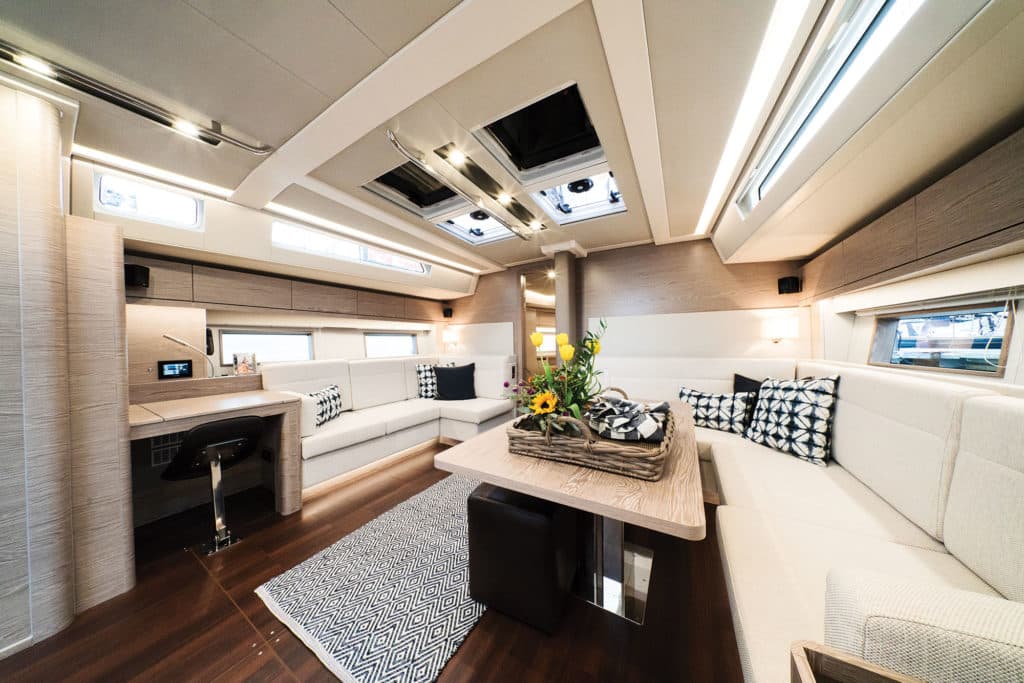
There’s nothing particularly fancy about the sandwich construction—it’s a “wet” layup of glass, vinylester and gelcoat surrounding an end-grain balsa core above the waterline, with carbon reinforcement in the chain-plate areas. A grid of solid fiberglass anchors the keel-stepped mast and the keel itself, of which there are three options: a deep T-shaped foil that draws better than 9 feet, and a pair of slightly shallower L-shaped foils in the 7- and 8-foot range, respectively. Soundown insulation in the flooring and cabins makes for a surprisingly quiet boat. There’s a substantial, sturdy composite bulwark that rims the deck, and a single rudder. The engine is a Yanmar 110 hp with a straight shaft (not a sail drive). C-Zone digital switching controls and monitors the electrical systems. Retractable thrusters fore and aft are helpful in gliding this handful of a boat in and out of tight places.
There are multiple interior plans from which to choose—including a pair of four-cabin versions with a set of double cabins and heads forward—but the standard, most popular layout, which was on our test boat, is a three-cabin model with a roomy owner’s suite in the bow (with a nice head and shower) and two ample double cabins aft (there’s also a small workroom to port that could also be specified as another head or a dedicated stateroom with bunkbeds). The main saloon is spacious and airy, and includes a straight-line galley aft to starboard, a navigation station to port, and lengthy settees, including an L-shaped one also to starboard that wraps around the dining table.
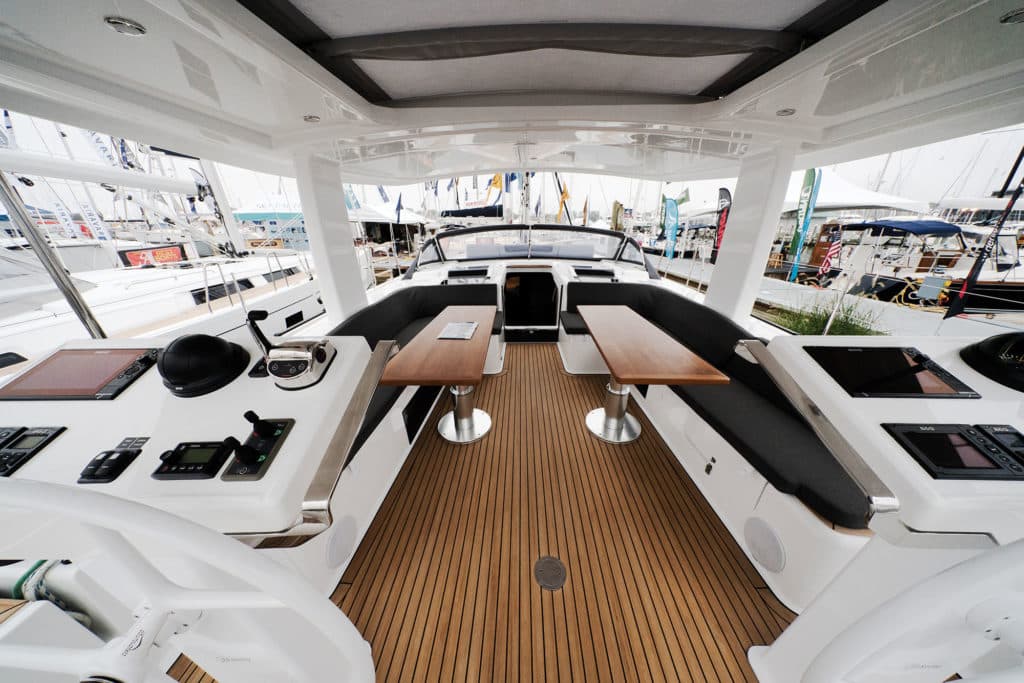
We test-sailed the boat on a day of rather fitful breezes that never reached even 10 knots, but it was plenty to get the 548 moving well. The two helms are independently connected to the rudder post, and feature big pedestals with two sets of controls for the engine, lights, thrusters, B&G instruments, autopilot, and so on (you hit a “select” button at whichever postion you’re driving from to take command). The cockpit is big, continuing the overall theme, with two dining tables split to each side, leaving a nice walk-through space in between. There’s a windscreen forward of the companionway, which has integral slats that disappear into a recess when not required.
The triple-spreader rig is tamed with a Seldén in-mast furler with an Elvstrom performance mainsail with vertical battens that was pretty and effective. The mainsheet is a German double-ended affair that leads aft to the helms. The smaller of the two headsails, as previously mentioned, is a self-tacking jib on its own track that makes tacking as simple as turning the wheel. The larger genoa, on the forward stay, is available for off-wind work. The versatile solent arrangement is really a sound solution for a cruising boat with a primary attribute of making miles in whatever the conditions.
And from what we saw, even in the light stuff, racking up miles won’t be an issue for the 548. In just about 7 knots of true wind hard on the breeze, the speedo touched 7 as well. It’s an easy boat to steer, with a balanced helm, and tracks beautifully. That low coach roof provides wonderful visibility forward. I jotted down a couple of notes as I jogged back and forth between wheels after tacks, one of which was in all caps: “FUN!”
And that’s precisely what sailboats are supposed to be, right? With the 548, and other recent launches, Hanse seems to have sorted that out. I guess it’s no wonder they’ve become a colossus.
Hanse 548 Specifications
| LENGTH OVERALL | 53’3″ (16.22 m) |
| WATERLINE LENGTH | 48’11” (14.90 m) |
| BEAM | 16’7″ (5.05 m) |
| DRAFT | 9’2″/7’3″ (2.8/2.2 m) |
| SAIL AREA (100%) | 1,485 sq. ft. (138 sq. m) |
| BALLAST | 14,555 lb. (6,602 kg) |
| DISPLACEMENT | 43,652 lb. (19,800 kg) |
| BALLAST/DISPLACEMENT | 0.33 |
| DISPLACEMENT/LENGTH | 166 |
| SAIL AREA/DISPLACEMENT | 19 |
| WATER | 203 gal. (770 L) |
| FUEL | 137 gal. (520 L) |
| MAST HEIGHT | 81’0″ (24.6 m) |
| ENGINE SPECIFICATIONS | Volvo 110 hp |
| DESIGNER | Judel/Vrolijk & Co. |
| PRICE | $800,000 |
Hanse Yachts
978-239-6568
hanseyachts.com
Sea Trial
WIND SPEED
7 to 9 knots
SEA STATE
Slight chop
SAILING
Closehauled 7.0 knots
Reaching 6.8 knots
MOTORING
Cruise (1,800 rpm) 6.9 knots
Fast (2,300 rpm) 8.3 knots

